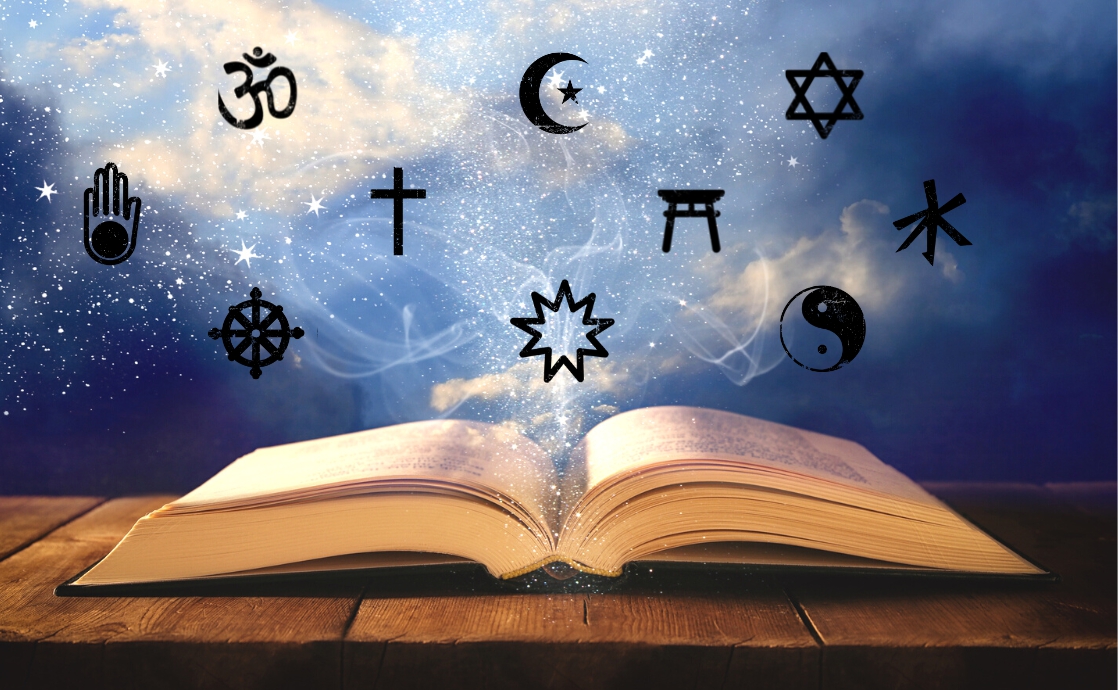The views expressed in our content reflect individual perspectives and do not represent the authoritative views of the Baha'i Faith.
Prophetic predictions about the return, or the future appearance of a scion or notable descendant of various divine messengers, are prophecies in their simplest and purest form.
Such prophecies — traditionally thought of as the very words of some of the great founders of the world’s religions — are probably the surest, purest, and most authentic prophecies we can seriously consider and reflect on.
RELATED: Has the Messiah Returned?
By “return” is not meant “reincarnation,” from a Baha’i perspective, even though it may very well mean reincarnation from a Hindu or Buddhist perspective. (See “The Promises of All the Prophets: I Will Return.”) Let’s look at this theme a little more fully, with a few examples of prophecies that appear to be reasonably genuine and authentic from true prophets:
The Return – or Scion – of Krishna
The Bhagavad Gita, or “Song of the Lord,” one of the great religious classics of all time, sets forth, in a poignant and sophisticated manner, the teachings of Krishna. This prophecy, from 4.7-8, is a well-known excerpt:
For whenever there is a decline in righteousness (dharma) and an increase in unrighteousness, Arjuna, then I emanate myself. For the protection of good people, for the destruction of evil-doers, and for the restoration of righteousness, I take birth in age after age. – Bhagavad Gita 4.7–8, translated by Richard H. Davis, The Bhagavad Gita: A Biography (Princeton and Oxford: Princeton University Press, 2015), pp. 24 and 198. See “The Prophecies of the Bhagavad-Gita” (Part 26) of this “Figuring Out Prophecy” series.
Here, the word “I” — although obviously in first-person, grammatically speaking — can either refer to Krishna himself, or someone like Krishna, in which case the word “I” can alternatively be understood to mean “someone like me” — which is an important concept to keep in mind since later Hindu texts foretell the coming of future “Avatars,” the final one being “Kalki Viṣṇuyaśas.” (See Parts 20, 21, 22, 23, 24, 32, and 61 of this “Figuring Out Prophecy” series.) In any case, the idea of the “return” of Krishna is evident here.
The Return – or Scion – of Moses
The following prophecy, attributed directly to Moses in Deuteronomy 18:18, is quite familiar to many if not most religious Jews and Christians:
I [God] will raise them up a Prophet from among their brethren, like unto thee [Moses], and will put my words in his mouth; and he shall speak unto them all that I shall command him.
Much could be said about this prophecy, which has been variously described as having been fulfilled by Jesus or, alternatively, by the prophet Muhammad — depending on the religious point of view, of course.
The Return – or Scion – of Zoroaster
The prophet Zoroaster (the Greek version of the person’s name is Zarathuštra), founded Zoroastrianism, a religion of great historical importance and of widespread influence. Due to its dwindling numbers today, however – as a result of a centuries-old policy that generally does not allow for converts – Zoroastrianism is a dying religion. In terms of prophecy, Zoroaster is said to have directly composed the following two stanzas (46.3 and 48.12) of his sacred hymns, known as the Gāthās:
Yasna 46.3:
When, o Wise One, will rise the bull of the days
in order to hold the life of truth,
the wits of Saošiiaṇts [Saviours], with mature teachings?
To whom will one go for fat with good thinking?
To teach me that I choose you, o Lord.
Yasna 48.12:
They will be Saošiiaṇts [Saviours] of the countries,
who pursue recognition with good thinking,
(the recognition) of your teaching, o Wise One, with their actions through truth;
for they are created as defeaters of Rage.
Translated by Almut Hintze, “The Rise of the Saviour in the Avesta,” Iran und Turfan: Beiträge Berliner Wissenschaftler, Werner Sundermann zum 60, Geburtstag gewidmet, edited by Christiane Reck and Peter Zieme (Wiesbaden: Harrassowitz, 1995), pp. 77–97 [pp. 81–82].
Faithful Zoroastrians believe these are the very words of Zoroaster himself.
The Return – or Scion – of Buddha
According to Buddhist scholar Than Grove, Ph.D., who wrote, “The Prophecy of the Superior Maitreya: A new translation from the Sanskrit and Tibetan” (2021), the original prophecy of the future Buddha may be as follows: “Possibly the earliest reference to Maitreya in the Buddha’s teachings can be found in a sūtra in the “Collection of Long Discourses” or Dīgha Nikāya. The sūtra called the [sic] The Lion’s Roar on the Turning of the Wheel Discourse (cakkavatti-sīhanāda-sutta). See Note 18. https://texts.mandala.library.virginia.edu/text/prophecy-maitreya. Here’s the prophecy:
And in that time of the people with an eighty thousand-year life-span, there will arise in the world a Blessed Lord, an Arahant fully-enlightened Buddha named Metteyya [translator’s note: “The next Buddha, perhaps better known by the Sanskrit name Maitreya”], endowed with wisdom and conduct, a Well-Farer, Knower of the worlds, incomparable Trainer of men to be tamed, Teacher of gods and humans, enlightened and blessed, just as I am now. He will thoroughly know by his own super-knowledge, and proclaim, this universe with its devas and māras and Brahmās, its ascetics and Brahmins, and this generation with its princes and people, just as I do now. He will teach the Dhamma, lovely in its beginning, lovely in its middle, lovely in its ending, in the spirit and in the letter, and proclaim, just as I do now, the holy life in its fullness and purity. He will be attended by a company of thousands of monks, just as I am attended by a company of hundreds. – The Buddha, The Long Discourses of the Buddha: A Translation of the Dīgha Nikāya, translated from the Pali by Maurice Walshe (Somerville, Massachusetts: Wisdom Publications, 1995), pp. 403–404, and p. 603, note 803.
As previously explained in this series, 80,000 years is most likely symbolic. (See Parts 27, 31, and 32 of this “Figuring Out Prophecy” series.)
The Return – or Scion – of Christ
Among the quite well-known prophecies of Jesus Christ’s regarding his return, the following stand out:
Whosoever therefore shall be ashamed of me and of my words in this adulterous and sinful generation; of him also shall the Son of man be ashamed, when he cometh in the glory of his Father with the holy angels. – Mark 8:38.
For the Son of man shall come in the glory of his Father with his angels; and then he shall reward every man according to his works. – Matthew 16:27.
For whosoever shall be ashamed of me and of my words, of him shall the Son of man be ashamed, when he shall come in his own glory, and in his Father’s, and of the holy angels. – Luke 9:26.
And I will pray the Father, and he shall give you another Comforter, that he may abide with you for ever; Even the Spirit of truth; whom the world cannot receive, because it seeth him not, neither knoweth him: but ye know him; for he dwelleth with you, and shall be in you. – John 14:16–17.
I have yet many things to say unto you, but ye cannot bear them now. Howbeit when he, the Spirit of truth, is come, he will guide you into all truth: for he shall not speak of himself; but whatsoever he shall hear, that shall he speak: and he will shew you things to come. – John 16:12–13.
In several past articles in this series, we’ve dealt extensively with the prophecies regarding Christ’s return.
RELATED: Literal or Not? Understanding Prophecies About Christ’s Return
The Scion or Descendant of Muhammad
Briefly, this is a complex topic involving distinct prophetic traditions from the two main “orthodoxies” in Islam – Sunni and Shia Islam. So this topic will be developed in a future article. Suffice it to say that prophecies of the “Mahdi” traditions ascribed to the prophet Muhammad have, according to Baha’i belief, been fulfilled by Baha’u’llah’s predecessor, the Bab. The Mahdi, according to both Sunni and Shia traditions, will be of the progeny of Muhammad.
Another descendant of Muhammad expected to “return” is the Imam Husayn. He was a highly respected grandson of the prophet Muhammad, and is acclaimed as the “Third Imam” (of “Twelve Imams” in mainstream Shia Islam). In Baha’i belief, Baha’u’llah is considered to be the return of Imam Husayn.
A Caution about Some Prophecies
On a cautionary note, however, a number of predictive texts exist in various religions which presage the future by describing an apocalyptic dystopia followed by a paradisiacal utopia. These texts purport to be from one or more of these great, charismatic prophets in which words are put into their mouths, so to speak. This type of literature is referred to by scholars as “pseudepigrapha” – which literally means “false writing” – in which an artificial “scripture” is ascribed to an ancient worthy in order to gain “authority” for the sacred text in question.
As time goes on, as we have tried to show throughout this “Figuring out Prophecy” series, the “eschatological” (prophetic/apocalyptic) traditions have become more varied, speculative, contradictory, and physically impossible of literal fulfillment without violating natural laws over time. In a word, that makes them problematic with respect to interpretation.
So, just as Jesus cautioned us to “Beware of false prophets,” we must also “beware of false prophecies.” That said, there is good reason to believe in most, if not all, of the prophecies set forth above, as being genuinely attributable to the great divine messengers to whom these predictions have been attributed. Whether or not any or all of these prophecies have been fulfilled is a matter of faith, pure and simple.
Baha’is believe that these prophecies are convergent — that is, they are part of a single vision of a future messenger of God, through the power of whose teachings the world will eventually unify. We can think of this idea of Baha’u’llah fulfilling several messianic prophecies at one and the same time — which is possible only if the prophecies themselves are convergent — as a kind of “multiple messiahship.”
Briefly, this is how Baha’u’llah summed up these intertwining prophetic traditions:
Say, God is my witness! The Promised One Himself hath come down from heaven, seated upon the crimson cloud with the hosts of revelation on His right, and the angels of inspiration on His left, and the Decree hath been fulfilled at the behest of God, the Omnipotent, the Almighty.
You be the judge for yourself, if you decide to investigate these remarkable truth-claims.
















Comments
Sign in or create an account
Continue with Googleor